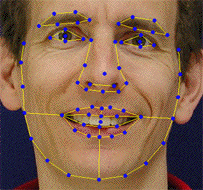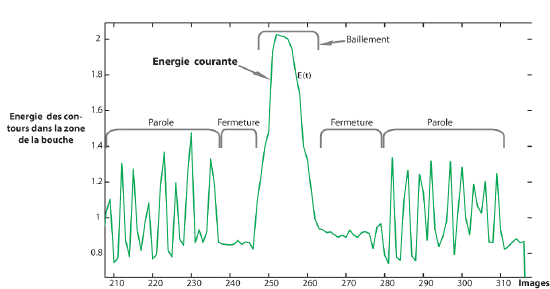- Drowsiness,
counter-measures to drowsiness, and the risk of
a motor vehicle crash Cummings P Injury
Prevention
2001;7:194-199
- Driving and
subsidiary behavior of taxi drivers working
alternate-day shifts Sakai K, Takahashi Y
Hum Ergol (Tokyo)
19754(2):115-27
- Temporal
change of subsidiary behavior in monotonous
work Kishida K Journal of
Human Ergology 1973;2:75-89
- Variation of
behavioral and physiological variables in
children attending kindergarten and primary
school Koch P, Montagner H, Soussignan R
Chronobiol. Internat
1987;4:525-535
- Yawning : effects
of stimulus interest R Provine, HB Hamernik
Bulletin of the Psychonomic
Society1986; 24; 6; 437-438
- Sopite
syndrome: a sometimes sole manifestation of
motion sickness Graybiel A, Knepton J
Aviat Space Environ Med 1976;47:
(8):873-82
- Sleep and
sleep-disordered breathing in commercial
long-haul truck drivers RA Stoohs et Al
Chest
1995;107:1275-82
- Monotony
of road environment and driver fatigue: a
simulator study Thiffault P, Bergeron J
Accid Anal Prev2003 May; 35(3);
381-91
- On yawning
and its functions Baenninger R et al
Psychonomic Bulletin &
Review 1997; t4; n 2
- Field
observations of yawning and activity in
humans Baenninger R et al
Physiol Behavior
1996;59(3):421-5
- On the
context of yawning: when, where, and why ?
Greco M, Baenninger R The
Psychological Record1993;43:175-183
- Some
antecedents and consequences of yawning
Baenninger R, Greco M The
Psychological Record1991;41:453-460
- Yawning elicited
by reading : is an open mouth sufficient
stimulus ? Carskadon MM
Sleep research
1991;20:116
- Yawning
elicited by reading : effect of sleepiness
Carskadon MM Sleep research
1992;21:101
- Hypovigilence
analysis: open or closed eye or
mouth?
Blinking
or yawning frequency? Benoit,
A. Caplier,
A. Advanced Video and
Signal Based Surveillance
2005:207-212
- Multimodal
focus attention and stress detection and
feedback in an augmented driver simulator.
Benoit A, Bonnard L et al. Pers
Ubiquit Comput 2009;13:33-41
- Monitoring
mouth movement for driver fatigue or distraction
with one camera Wang Rongben Guo Lie Tong
Bingliang Jin Lisheng Transp.
Coll., Jilin Univ., Changchun, China Intelligent
Transportation Systems, 2004. Proceedings. The
7th International IEEE Conference (3-6 Oct.
2004;314 -319)
- Yawning
detection for determining driver drowsiness
Tiesheng Wang Pengfei Shi
Inst. of Image Process. &
Pattern Recognition, Shanghai Jiao Tong Univ.,
China VLSI Design and Video Technology, 2005.
Proceedings of 2005 IEEE International Workshop
(28-30 May 2005:373-376)
- Determining
driver visual attention with one camera
Smith, P. Shah, M. da Vitoria Lobo, N. -
Dept. of Comput. Sci., Central
Florida Univ., Orlando, FL, USA Intelligent
Transportation Systems, IEEE
2003;4(4):205-218)
- Comparison
of impedance and inductance ventilation sensors
on adults during breathing, motion, and
simulated airway obstruction Cohen, K.P.
Ladd, W.M. Beams, D.M. Sheers, W.S. Radwin, R.G.
Tompkins, W.J. Webster, J.G.
Lincoln Lab., MIT, Lexington,
MA, USA Biomedical Engineering, IEEE 1997; 44(7
):555-566
- Public
speaking in virtual reality: facing an audience
of avatars Slater, M. Pertaub, D.-P. Steed,
A. pdf
Dept. of Comput. Sci., Univ.
Coll. London, UK Computer Graphics and
Applications, IEEE 1999;19(2):6-9
- Hidden
markov model based dynamic facial action
recognition Arsic, D. Schenk, J. Schuller,
B. Wallhoff, F. Rigoll, G.
Technische Universität
München, Institute for Human Machine
Communication, Arcisstrasse 16, 80333
München, Germany. Image Processing, 2006
IEEE 2006: 673-676
- A
newly proposed disease condition produced by
light exposure during night:
Asynchronization Kohyama J
Brain & Development
2009;31:255-273
- Gabor-based
dynamic representation for human fatigue
monitoring in facial image sequences Xiao
Fan et al Pattern Recognition
Letters 2010;31:234-243
- Improving
classification rates for use in fatigue
countermeasure devices using brain activity.
Tran Y, Craig A, Wijesuriya N, Nguyen H.
Conf Proc IEEE Eng Med Biol Soc.
2010;2010:4460-4463
- Awareness
of sleepiness and ability to predict sleep
onset: can drivers avoid falling asleep at the
wheel? Kaplan KA, Itoi A, Dement
WC. Sleep Med.
2007;9(1):71-79.
- Yawning
as a behavioral marker of mild motion sickness
and sopite syndrome. Matsangas P, McCauley
ME. Aviat Space Environ Med
2014;85:658-661
- Examining
signs of driver sleepiness, usage of sleepiness
countermeasures and the associations with sleepy
driving behaviours and individual factors.
Watling CN et al.
- A
Novel Fatigue Driving State Recognition and
Warning Method Based on EEG and EOG Signals.
Liu and al.
- EEG
driving fatigue detection based on log-Mel
spectrogram and convolutional recurrent neural
networks. Gao D et al.
- Detection
of Drowsiness among Drivers Using Novel Deep
Convolutional Neural Network Model. Majeed
F, et al.
- Multi-Index
Driver Drowsiness Detection Method Based on
Driver's Facial Recognition Using Haar Features
and Histograms of Oriented Gradients
- A
Real-Time Embedded System for Driver Drowsiness
Detection Based on Visual Analysis of the Eyes
and Mouth Using Convolutional Neural Network and
Mouth Aspect Ratio
- Makhmudov
F, Turimov D, Xamidov M, Nazarov F, Cho YI.
Real-Time Fatigue Detection Algorithms Using
Machine Learning for Yawning and Eye State.
Sensors (Basel). 2024;24(23):7810.
-
-

- Ergology
and yawning : field
observations
-
- If yawning is somehow related to
level of arousal, one would expect yawns to
occur frequently when transitions between
different levels of arousal are required, as
when people are first getting up in the morning,
when they are retiring for the night. A less
obvious prediction from this arousal hypothesis
is that people should yawn frequently while
attending lectures, and when driving a car. This
was what we found:
-
- For experienced drivers driving is a relaxed
activity for which a certain level of arousal
(or at least attention) is needed occasionally.
P Cummings
wish to perform the knowledge of how dfferent
indicators of drowsiness affect crash risk might
be useful to drivers. He expected that
yawning might indicate drowsiness;
contrary to this expectation, drivers who
recalled yawning were at decreased risk of a
crash!
-
- K Sakai,
in 1975, have study on taxi drivers working
alternate-day shifts of a prescribed duration of
16 hr of work revealed that most of them
actually worked longer for 16 hr 50 min on the
average, starting from 7:00 and ending later
than 2:00. This resulted in retarded mean
bedtime after the shift end and in reduced
sleep. The total rate of subsidiary activities
of the drivers decreased during the middle of
the day, but increased, towards the shift end.
Those activities having a relatively low rate at
the beginning, such as subsidiary lower limb
movements, shoulder-neck movements, and
yawning, remarkably increased in the late
evening and midnight hours.
-
-
- K
Kishida : temporal changes behavior of
assembly workers performing monotonous tasks
were investigated by recording their subsidiary
activities such as chattering, looking around,
changing positions, arranging hair,
yawning, etc., and the results were
compared among three work patterns; conveyor
lines with fixed work rates, conveyor lines with
variable tasks, and table-type assembly shops.
These subsidiary activities usually increased
gradually after about half an hour from the
beginning of each work session. The increasing
tendency was the most conspicuous on the
conveyor lines with variable tasks, moderate in
table-type shops, and suppressed on the conveyor
lines with severe and constant pacing. In
severely paced conveyor workshops, the less the
waiting time was included, the smaller was the
frequency of subsidiary activities. The average
decline of the critical flicker frequency or the
color naming speed was negatively correlated
with the mean frequency of subsidiary activities
of the workshop, while more subjective fatigue
feelings were claimed by workers of fixed-rate
assembly lines than those of other work patterns
with respect to dullness and shoulder
stiffness.
-
- Ergologie
et bâillements : champs
d'observation
-
- De nombreux facteurs peuvent
déclencher des bâillements. L'ennui
et les travaux
monotones répétitifs sont les
plus connus. Ainsi, Provine
a montré qu'il existe, chez des
étudiants de 18 ans, une
corrélation significative entre le nombre
et la durée des bâillements
survenant pendant deux situations
différentes : lors de la visualisation
d'un film attrayant, ces paramètres sont
inférieurs à ceux relevés
à l'occasion d'une projection
vidéo monotone et
inintéressante.
-
- Chez l'enfant, le bâillement
est aussi en relation avec les rythmes
scolaires et les habitudes de vie (Koch).
Lors du passage de l'école maternelle -
peu contraignante - à la première
année de primaire - où se fait
l'apprentissage de la lecture et du calcul qui
nécessitent une attention soutenue et des
efforts mentaux importants - la proportion
d'enfants bâilleurs croit
significativement.
-
- Comportement traduisant fatigue, ennui,
somnolence et baisse de vigilance, le
bâillement a été
étudié sous l'angle de
l'ergologie:
-
- P
Cummings présente une étude
sur les indicateurs de fatigue au volant
après une enquête approfondie,
ayant duré 18 mois, des causes
d'accidents sur une autoroute américaine.
Le bâillement est un signe
perçu comme une alerte par les
conducteurs; ceux qui bâillent ont eu
moins d'accidents que les autres !
-
- K Sakai,
en 1975, décrit le rythme
effréné de travail des chauffeurs
de taxis japonais, 270 heures par mois. Pour
lutter contre la somnolence, ils utilisent
différentres stratégies :
changement de positions, étirements,
bâillements, dont la fréquence
varie au cours des heures de travail.
-
- K
Kishida s'est penché sur le
comportement des travailleurs postés sur
une chaîne, au travail monotone et
répétitif. Là aussi, de
multiples comportements essaient d'adapter la
vigilance qui se relâche : bavardage,
regards circulaires, changements de position,
étirements,
bâillements.
-
- A voir également :
- La somnolence. Modèles
expérimentaux M Jouvet
Neurophysiol Clin 1993; 23;
291-303
- Travail posté : comment diminuer les
conséquences sur l'organisme
La Revue du Praticien
Médecine Générale 31 mars
2003; t 17; n 608; p469-471
- Psychophysiological responses to changes in
workload during simulated air traffic control
J.B. Brookings, G. F. Wilson, C.R.
Swain Biological Psychology
1996; 42; 361-377
- The three-process model of alertness and its
extension to performance, sleep latency, and
sleep length T Akerstedt, S Folkard
Chronobiology International
1997;14(2); 115-123
- Sleepiness on the job: continuously measured
EEG changes in train drivers L Torsvall, T
Akerstedt Electroencephalography
and Clinical Neurophysiology 1987; 66;
502-511
- Habitually Sleepy drivers have a high
frequency of automobile crashes associated with
respiratory disorders during sleep Masa JF,
Rubio M, Larry J et al Am J
Respir Crit Care Med
2000;162:1407-1412
-
Hypovigilence
analysis: open or closed eye or
mouth?
- Blinking
or yawning frequency?
- Benoit, A. Caplier,
A.
- LIS-INPG, Grenoble,
France
- Advanced Video and Signal
Based Surveillance
- AVSS
2005:207-212
 -
- Hypovigilance
analysis: blinking or yawning frequency
?
-
- This paper proposes a frequency method to
estimate the state open or closed of eye and
mouth and to detect associated motion events
such as blinking and yawning. The context
of that work is the detection of hypovigilence
state of a user such as a driver, a pilot.
-
- This method is used to estimate the motion
of eye and mouth: blinking are related to fast
vertical motion of the eyelid and yawning
is related to large vertical mouth opening. The
detection of the open or closed state of the
feature is based on the analysis of the total
energy of the image at the output of the retina
filter: this energy is higher for open
features.
-
- The absolute level of energy associated to a
specific state being different from a person to
another and for different illumination
conditions, the energy level associated to each
state open or closed is adaptive and is updated
each time a motion event (blinking or
yawning) is detected. No constraint about
motion is required. The system is working in
real time and under all type of lighting
conditions since the retina filtering is able to
cope with illumination variations. This allows
to estimate blinking and yawning
frequencies which are clues of
hypovigilance.
-
 -
- La courbe d'illustration montre
l'évolution temporelle du critère
d'analyse. Ce critère est une
énergie à chaque instant
liée à la quantité de
contours dans la zone d'analyse (la bouche). On
observe sur cette illustration que
l'évolution temporelle de ce
critère permet d'identifier sans
hésitation un
bâillement par
rapport aux autres cas de figure : forte et
durable élévation de
l'énergie lors de l'ouverture et de
même lors de la fermeture lors du
bâillement.
-
- Détecter
l'hypovigilance: comment quantifier les
clignotements des paupières ou des
bâillements?
-
- Dans cet article, les auteurs proposent une
méthode de détection des
ouvertures ou fermetures des paupières ou
de la bouche. Celle-ci permet alors d'analyser
la fréquence des clignements des yeux ou
les bâillements. La finalité
est de mettre au point une technique capable de
dépister les états de somnolence,
par exemple, chez des conducteurs ou des
pilotes.
-
- Ergology
and yawning : field
observations
-
- A
graphic method of recording the act of yawning
and other forms of movement of the
mouth
- Iu. N. Bordiushkov
- Biull Eksp Biol Med
1958;46(7):885-887
-
- Monitoring
mouth movement for driver fatigue or distraction
with one camera
- Wang Rongben Guo Lie Tong Bingliang Jin
Lisheng
- Transp. Coll., Jilin Univ.,
Changchun, China
- Intelligent Transportation
Systems, 2004. Proceedings. The 7th
International IEEE Conference (3-6 Oct. 2004;314
-319)
-
- Yawning
detection for determining driver drowsiness
- Tiesheng Wang Pengfei Shi
- Inst. of Image Process.
& Pattern Recognition, Shanghai Jiao Tong
Univ., China
- VLSI Design and Video
Technology, 2005. Proceedings of 2005 IEEE
International Workshop (28-30 May
2005:373-376)
-
- Determining
driver visual attention with one camera
- Smith, P. Shah, M. da Vitoria Lobo, N.
- Dept. of Comput. Sci.,
Central Florida Univ., Orlando, FL, USA
- Intelligent Transportation
Systems, IEEE 2003;4(4):205-218)
-
- Comparison
of impedance and inductance ventilation sensors
on adults during breathing, motion, and
simulated airway obstruction
- Cohen, K.P. Ladd, W.M. Beams, D.M. Sheers,
W.S. Radwin, R.G. Tompkins, W.J. Webster,
J.G.
- Lincoln Lab., MIT,
Lexington, MA, USA
- Biomedical Engineering, IEEE
1997; 44(7 ):555-566
-
- Public
speaking in virtual reality: facing an audience
of avatars
- Slater, M. Pertaub, D.-P. Steed, A.
pdf
- Dept. of Comput. Sci., Univ.
Coll. London, UK
- Computer Graphics and
Applications, IEEE 1999;19(2):6-9
-
- Hidden
markov model based dynamic facial action
recognition
- Arsic, D. Schenk, J. Schuller, B. Wallhoff,
F. Rigoll, G.
- Technische Universität
München, Institute for Human Machine
Communication, Arcisstrasse 16, 80333
München, Germany.
- Image Processing, 2006 IEEE
2006: 673-676
|




